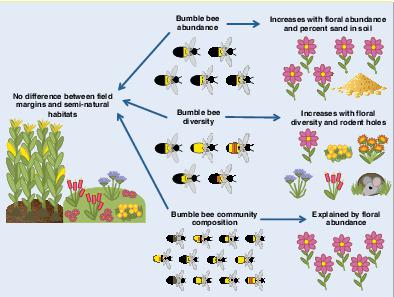当前位置:
X-MOL 学术
›
Insect Conserv. Divers.
›
论文详情
Our official English website, www.x-mol.net, welcomes your
feedback! (Note: you will need to create a separate account there.)
Agricultural field margins provide food and nesting resources to bumble bees (Bombus spp., Hymenoptera: Apidae) in Southwestern Ontario, Canada
Insect Conservation and Diversity ( IF 3.2 ) Pub Date : 2019-09-11 , DOI: 10.1111/icad.12381 Emily E.N. Purvis 1 , Matthew L. Meehan 1 , Zoë Lindo 1
中文翻译:

农业领域的利润为加拿大西南安大略省的大黄蜂(Bombus spp。,膜翅目:Apidae)提供了食物和筑巢资源。
更新日期:2019-09-11
Insect Conservation and Diversity ( IF 3.2 ) Pub Date : 2019-09-11 , DOI: 10.1111/icad.12381 Emily E.N. Purvis 1 , Matthew L. Meehan 1 , Zoë Lindo 1
Affiliation

|
- Bumble bees are declining globally, largely due to habitat loss driven by agricultural intensification. Within agriculturally dominated landscapes, semi‐natural habitats (e.g. meadows, wetland edges) are fragmented, increasing the value of uncropped agricultural field margins for providing a source of food, nesting, and hibernation resources to bumble bees.
- We compared bumble bee communities sampled in agricultural field margins and semi‐natural habitats across Southwestern Ontario, Canada in order to assess differences in habitat quality. We then examined the effect of floral resources and soil characteristics on the bumble bee communities present in each site, independent of the habitat type classification.
- Our data revealed that bumble bee abundance, diversity, and community composition did not differ between habitat types. However, when examined independently of habitat type, bumble bee abundance and diversity increased with floral abundance, floral diversity, the number of rodent holes, and sandy soil texture.
- These results suggest that agricultural field margins are not inherently degraded bumble bee habitat and have the potential to provide food and nesting resources comparable to semi‐natural habitats in a fragmented agricultural landscape. Ensuring field margins contain the necessary floral resources and soil characteristics for bumble bees has implications for conservation and mitigating habitat loss caused by the agricultural fields themselves.
中文翻译:

农业领域的利润为加拿大西南安大略省的大黄蜂(Bombus spp。,膜翅目:Apidae)提供了食物和筑巢资源。
- 大黄蜂在全球范围内正在下降,这主要是由于农业集约化导致的栖息地丧失。在以农业为主的景观中,半自然生境(例如草地,湿地边缘)支离破碎,从而增加了未耕种的农田边际的价值,可为蜜蜂提供食物,筑巢和冬眠资源。
- 为了评估栖息地质量的差异,我们比较了加拿大西南安大略省农田边缘和半自然栖息地中的大黄蜂群落。然后,我们检查了花卉资源和土壤特征对每个地点的大黄蜂群落的影响,而与栖息地类型分类无关。
- 我们的数据表明,大黄蜂的丰度,多样性和群落组成在不同的生境类型之间没有差异。但是,当独立于栖息地类型进行检查时,大黄蜂的丰度和多样性随着花的丰度,花的多样性,啮齿动物的孔的数量和沙质土壤的质地而增加。
- 这些结果表明,农田边缘并不是固有的退化的大黄蜂栖息地,而是有潜力在零散的农业景观中提供与半自然栖息地相当的食物和筑巢资源。确保田间边缘含有必要的花卉资源,而且大黄蜂的土壤特性对保护和减轻由农田本身造成的栖息地丧失具有影响。











































 京公网安备 11010802027423号
京公网安备 11010802027423号